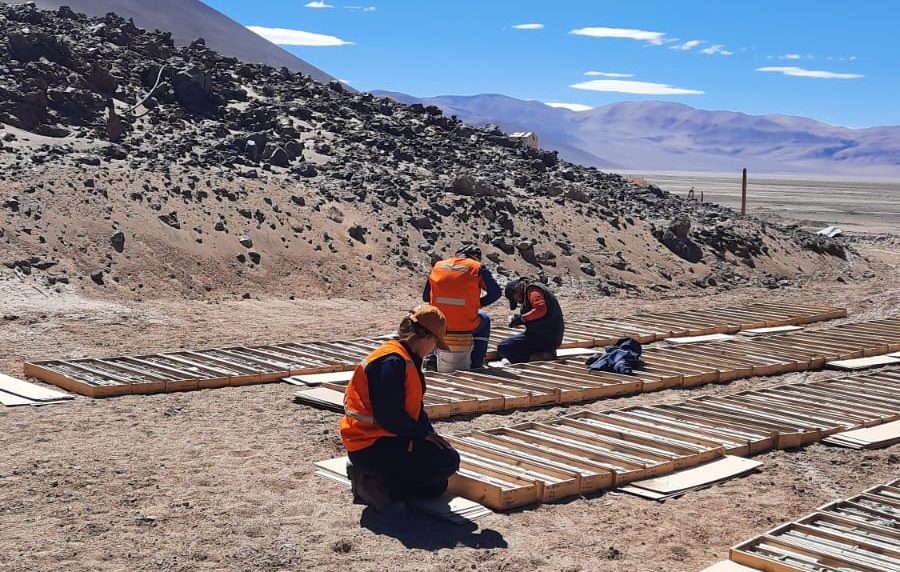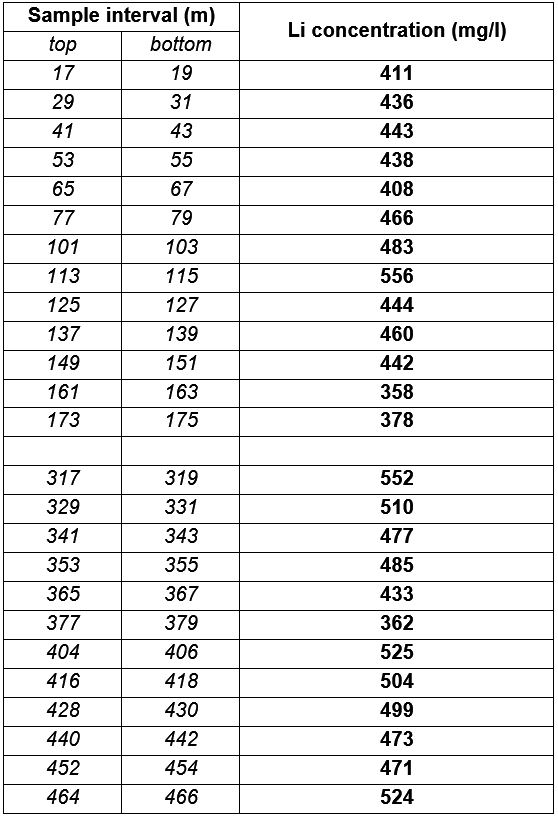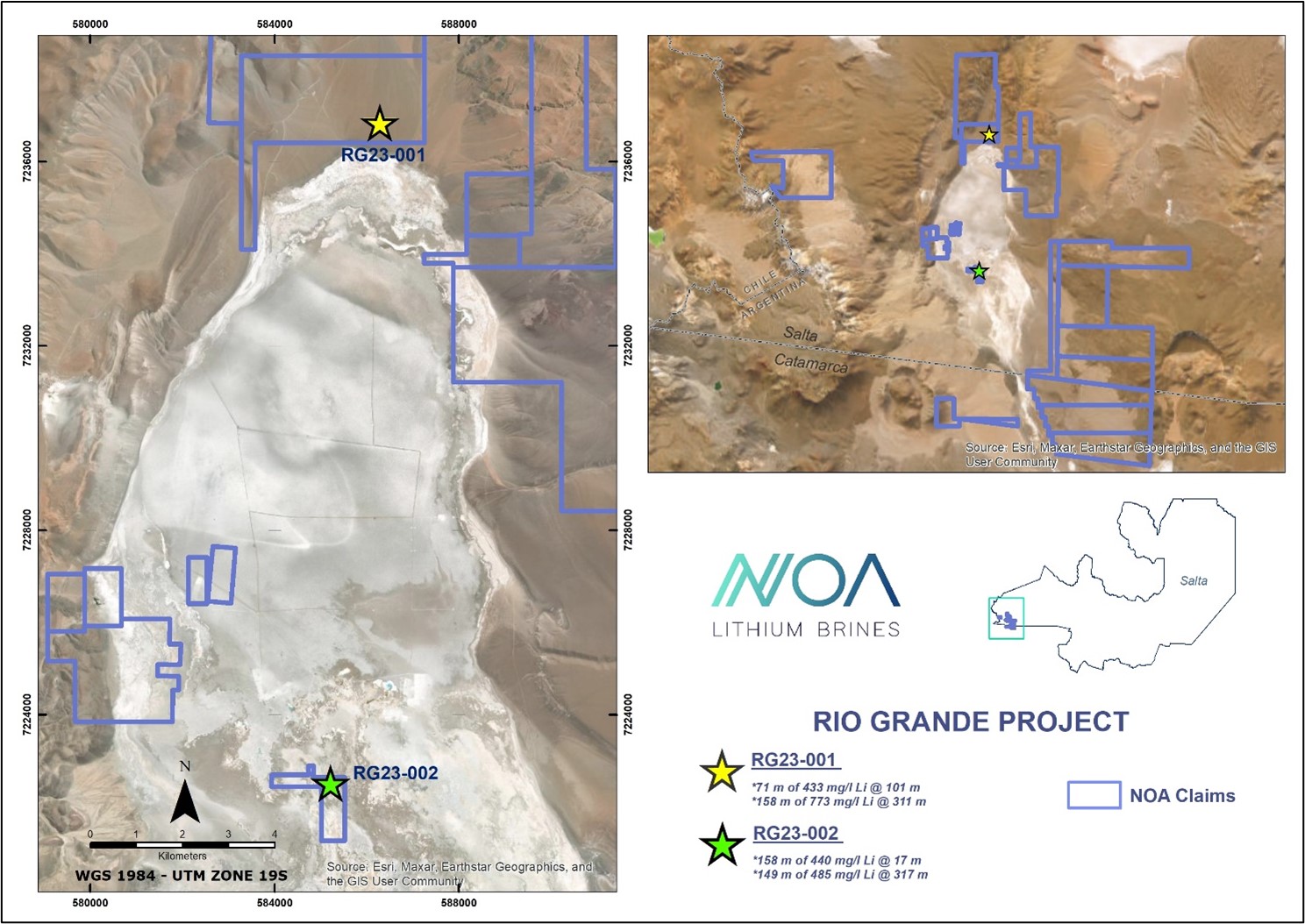NOA’s Second Hole at Rio Grande Intercepts 307 m of High-Grade Lithium Brine Over Two Aquifers, With Grades Up To 556 mg/l Li

NOA Lithium Brines Inc. (TSX-V: NOAL, FSE: N7N) (“NOA” or the “Company”) is pleased to report positive lithium results from brine samples from RG23-002, the second hole of the Phase 1 diamond drill program at its Rio Grande project (“Rio Grande” or “the Project”) located in Salta Province, Argentina. The hole was drilled within the salar, approximately 14 kilometers (“km”) south of the first hole on the Project and intersected two high-grade lithium (“Li”) brine aquifers of significant thickness. Highlights include:
- 158 meter (“m”) permeable interval with grades up to 556 milligrams per liter (“mg/l”) Li, and averaging 440 mg/l, starting at a depth of 17 m
- 149 m permeable interval with grades up to 552 mg/l Li, and averaging 485 mg/l Li, starting at a depth of 317 m, representing a newly discovered deeper aquifer in the salar
Taj Singh, President and CEO states: “Following up on our successful first hole at Rio Grande, our second hole, 14 km south, the deepest publicly reported drill hole on the Rio Grande salar, builds on our excitement for the Project. As in the first hole, RG23-002 intercepted two thick, high-grade brine horizons; the first aquifer was intercepted at very shallow depths and the second aquifer was a new discovery starting approximately 300 m from surface.
“Both aquifers returned some of the top grades ever encountered on the Rio Grande salar and the brine intervals’ grades and total thickness rank among the highs of the region. These grades once again exceeded our expectations, and the discovery of the second aquifer within the salar was extremely encouraging. As in our first hole, brine geochemistry and permeability were consistent and positive for future process planning.”
Both aquifers demonstrate potential to extend into NOA’s claimblocks on other parts of the salar and may continue past the surface manifestation of the salar (visible salar) and into the alluvials within the basin. This second hole follows on the discovery of significant lithium-bearing brines in the first hole, RG23-001 (see NOA News Release dated June 22, 2023). In that hole two stacked aquifers in the northern alluvials of the salar were discovered: a permeable brine interval of 71 m averaging 433 mg/l Li starting at 101 m downhole and an interval of 158 m averaging 773 mg/l Li (and up to 925 mg/l Li) starting from 311 m downhole.
Results for Hole RG23-002
The results of the brine analyses and the respective intervals are shown in Table 1 below and drill collar information is presented in Table 2 below. Hole RG23-002, drilled at the Cynthia Ines claim (shown in Figure 1 below) reached a depth of 642 m. Magnesium-to-lithium ratios averaged ~10:1 across the hole.
Table 1: Interval data & Li assays (double-packer sampling) for drillhole DDH-RG23-002

Hole RG23-002 was executed with diamond drilling (HQ-size), permitting the extraction of core samples of the salar basin formations and collection of brine samples where possible. Drilling was carried out by Salta-based Hidrotec S.A., under the supervision of NOA’s geologists. Sample analysis and QA/QC notes are outlined in a separate section below.
Several salar evaporite and semi-consolidated sedimentary lithologies were intersected downhole. From just under surface to approximately 120 m depth the hole progressed through well-sorted black sands followed by approximately 60 m of fractured halite. From approximately 180 m to 480 m sandy fractured halite was dominant and beyond this, sandy crystalline halite.
The Phase 1 drill program comprises six holes designed to deliver a maiden mineral resource estimate for the Rio Grande project in early 2024. The location of RG23-002 and completed hole RG23-001 are shown in Figure 1.
Figure 1: Plan map showing Hole RG23-002 (current release) and RG23-001 (completed)
Table 2: RG23-002 – Drill collar information

About NOA Lithium Brines Inc.
NOA is a lithium exploration and development company formed to acquire assets with significant resource potential. All NOA’s projects are in the heart of the prolific Lithium Triangle, in the mining-friendly province of Salta, Argentina, near a multitude of projects and operations owned by industry leaders. NOA has rapidly consolidated one of the largest lithium brine claim portfolios in this region not owned by a producing company, with key positions on three prospective salars (Rio Grande, Arizaro, Salinas Grandes) and a total portfolio of approximately 100,000 hectares.
On Behalf of the Board of Directors,
Taj Singh, M.Eng, P.Eng, CPA
President & CEO, Director
For Further Information
Website: www.noalithium.com
Email: info@noalithium.com
Telephone: 416-568-1027
References
[1] Rio Grande Project Technical Report, 2022, prepared by Montgomery and Associates Consultores Limitada (https://www.noalithium.com/projects/rio-grande/reports/)
Sample analysis & QA/QC Program
The drillhole of the current release was inclined vertically (90 degrees) and the salar strata are believed to be flat-lying resulting in reported intervals approximating true thickness.
The Company has a robust QA/QC and sample management program. Brine samples were collected by a single / double packer system (in-hole inflatable) to isolate specific intervals down the drillhole. The packer sampling method allows the collection of brine samples at specific depths while sealing the hole at the top and bottom of the interval. The packer system was run several times to flush the hole after drilling to clear / clean the hole prior to sampling and four samples for each interval were collected (main sample, duplicate sample, check sample, reserve sample).
Sample collection between 388-400 m was limited by the presence of compacted sands. A double-packer sample from 389-391 m was collected (assayed 163 mg/l Li) but was considered a diluted sample due to the limited permeability of the sample site.
Samples of brine were submitted by courier for analysis to SGS Argentina S.A., the local subsidiary of SGS International, an accredited laboratory for the analysis of lithium and other elements. SGS employed Inductively Coupled Plasma Optical Emission Spectrometry as the analytical technique for the primary constituents of interest, including: boron, calcium, potassium, lithium, and magnesium. Measurements in the field included pH, conductivity, temperature and density. The quality of sample analytical results was controlled and assessed with a protocol of blank, duplicate and standard samples included within the sample sequence. Differences between original and duplicate samples and results for standards and blanks are considered within the acceptable range for lithium.
Qualified Person
Taj Singh, P.Eng, President & CEO, NOA Lithium Brines Inc., is the Company’s designated Qualified Person for this news release within the meaning of National Instrument 43-101 Standards of Disclosure for Mineral Projects. Mr. Singh has reviewed and validated that the information contained in this news release is accurate.
Cautionary Note Regarding Forward-Looking Statements
This news release may include forward-looking statements that are subject to inherent risks and uncertainties. All statements within this news release, other than statements of historical fact, are to be considered forward looking statements. Forward-looking statements including, but not limited to NOA’s future plans and objectives regarding its projects, which constitute forward looking information that involve various risks and uncertainties. Although NOA believes the expectations expressed in such forward-looking statements are based on reasonable assumptions, such statements are not guarantees of future performance and actual results or developments may differ materially from those described in forward-looking statements. Factors that could cause actual results to differ materially from those described in forward-looking statements include fluctuations in market prices, including metal prices, continued availability of capital and financing, and general economic, market or business conditions. There can be no assurances that such statements will prove accurate and, therefore, readers are advised to rely on their own evaluation of such uncertainties. NOA does not assume any obligation to update any forward-looking statements except as required under applicable laws.
Neither TSX Venture Exchange nor its Regulation Services Provider (as that term is defined in policies of the TSX Venture Exchange) accepts responsibility for the adequacy or accuracy of this release.

